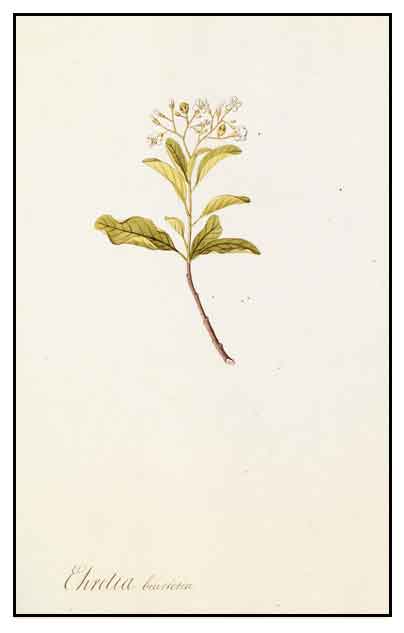
Family • Boraginaceae
Alibuñgog
Ehretia philippinensis A. DC.
| Scientific names | Common names |
| Ehretia lanyuensis Tang S.Liu & T.I.Chuang | Aliboñgog (Ism.) |
| Ehretia philippinensis A. DC. | Alibuñgog (C. Bis.) |
| Ehretia takaminei Hatus. | Anonañgin (Bik.) |
| Bayukon (Tag.) | |
| Halimumog (Tag.) | |
| Kalamuñgog (P. Bis.) | |
| Kutup (Sul.) | |
| Liñguñgug (Mbo.) | |
| Ludungla (Bon.) | |
| Salimomo (Tag.) | |
| Talibobong (Bik.) | |
| Ehretia philippinensis A.DC. is an accepted name. The Plant List | |
Distribution Constituents Properties Studies Availability |
© Godofredo U. Stuart Jr., M.D. |
Updated June 2018 / September 2016
![]()
 |
| IMAGE SOURCE: Ehretia beurreria / Rare Books from the MBG Library / Illustrated Garden |
| Simpol LR, Otsuka H, Ohtani K, Kasai R, Yamasaki K. Nitrile gluco-sides and rosmarinic acid, the histamine inhibitor from Ehretia philippinensis. Phytochemistry. 1994;36:91–95. |
| Additional
Sources and Suggested Readings (1) Chemical Constituents and Biological Activities of Plants from the genus Ehretia Linn. / LI Li, PENG Yong, YAO Xia, XU Li-jia, WULAN Ta-na, LIU Yong, SHI Ren-bing, XIAO Pei-gen / Chinese Herbal Medicines, 2010, 2(2): 106-111 (2) Nitrile glucosides and rosmarinic acid, the histamine inhibitor from Ehretia philippinensis / Lourdes R. Simpol, Hideaki Otsuka, Kazuhiro Ohtani, Ryoji Kasai, Kazuo Yamasaki / Phytochemistry, 01/1994; 36(1):91-95. / DOI:10.1016/S0031-9422(00)97019-5 (3) Ehretia philippinensis A.DC. / Synonyms / The Plant List (4) Ehretia philippinensis A. DC. / PROSEA (5) Antimicrobial Properties of Crude Ethanolic Extract from Roots and Leaves of Ehretia philippinensis A. DC. Against Staphylococcus aureus and Pseudomonas aeruginosa / Ma. Cristina Soledad E. Atotubo and Vanessa Mae R. de la Torre / Thesis: June 2017 / De La Salle University--Dasmariñas, College of Science and Computer Studies |
| It is not uncommon for links on studies/sources to change. Copying and pasting the information on the search window or using the DOI (if available) will often redirect to the new link page. |
• |
 |

 Botany
Botany